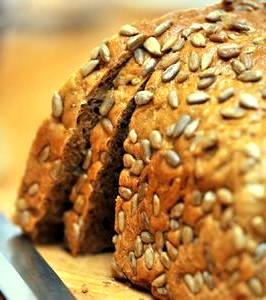- Home
- Blog
- Student Material
- Grains and legumes health report
Grains and legumes health report
Written by Catherine Saxelby
on Thursday, 12 August 2010.
Tagged: grains, guides, legumes, nutrition, whole grain, whole grains, wholegrain

In April 2010, GoGrains released a report named ‘The Grains and Legumes Health Report'. It's a 27 page A4-size book that can be ordered or downloaded free from the GoGrains website. It gives you an overview of the latest scientific research about grains, legumes (dried peas, beans and lentils) and health. The report reviews the health benefits of wholegrains and legumes with regards to cardiovascular health, type 2 diabetes, weight management and cancer. Here we present a short summary for students and teachers.
Wholegrains, and increasingly legumes, appear to play a role in protecting against heart disease, type 2 diabetes, certain cancers and obesity. Interestingly, research indicates wholegrain foods may help prevent asthma and gum disease, and may also improve mood and cognitive (brain) function. The report was written jointly by GoGrains Health & Nutrition and the University of Wollongong.
Key findings of the report are:
- Eating 2 to 3 serves of wholegrain foods a day can reduce the risk of developing cardiovascular disease, type 2 diabetes, certain cancers and obesity by 20 to 30%.
- Eating 2 to 4 serves of wholegrain foods a day can reduce the risk of heart disease by as much as 40%, equal to the effect of cholesterol lowering drugs.
- Wholegrain foods can help lower blood pressure.
- A diet that includes frequent consumption of wholegrains may reduce the progression from impaired glucose tolerance to type 2 diabetes by up to 58%.
- A diet high in wholegrains is associated with a lower Body Mass Index (BMI), waist circumference and risk of being overweight and can assist in weight loss as part of a kilojoule controlled diet.
- Epidemiological studies consistently show that eating legumes can help reduce the risk of cardiovascular disease, diabetes and obesity as well as improve gut health.
- Eating legumes four times or more a week, compared with less than once a week, has been shown to reduce the risk of heart disease by 22% and cardiovascular disease by 11%.
Defining wholegrains
 Australian food regulations define the term ‘wholegrain' as:
Australian food regulations define the term ‘wholegrain' as:
"the intact grain or the dehulled, ground, milled, cracked or flaked grain where the constituents - endosperm, germ and bran - are present in such proportions that represent the typical ratio of those fractions occurring in the whole cereal, and includes wholemeal" (page 5 of the Report).
Wholegrain products vary in the amount of wholegrains they contain. You'll generally see information about the wholegrain content on the label.
Products labelled as ‘wholegrain' are required to state the proportion of wholegrains they contain (expressed as a percentage) in the ingredient list.
Wholegrain recommendations
In 2008, GoGrains in consultation with the International Life Sciences Institute (ILSI), estimated an Australian daily target, per day, for wholegrain intake of:
- 24 g for children 2-3 years of age
- 32-40 g for children 4-8 years of age
- 48 g for children from 9 years of age
- 48 g for adults
(This is not an official Government recommendation but a guide to help you measure how much you're eating).
The table below (taken from page 7 of this Review) includes examples of wholegrain foods and their approximate wholegrain content.
| Wholegrain food |
Serve size |
Wholegrain content (approx) |
| Wholemeal bread | 2 slices | 30-40 g |
| Multi-grain bread | 2 slices | 5-30 g |
| Wheat-flake breakfast biscuits | 2 biscuits | 30 g |
| Wholegrain breakfast cereal | 30-45g | 15-30 g |
| Natural muesli | 1/2 cup | 30-40 g |
| Porridge (raw oats) | 1/3 cup | 30 g |
| Brown rice, cooked | 1 cup | 65 g |
| Wholegrain pasta, cooked | 1 cup | 55-65 g |
| Rice cakes, thin | 4 (24 g) | 20 g |
| Popcorn (plain) | 2 cups (20 g) | 15 g |
| Muesli bar | 1 bar (40 g) | 10-15 g |
How much to consume?
For adults to achieve the recommended daily intake of 48 grams, you would need to consume one to 4 serves of wholegrains per day, depending on the wholegrain content. Examples:
1 cup cooked brown rice
or
2 slices wholemeal bread plus 4 rice cakes
or
½ cup natural muesli plus 1 muesli bar
More information
- Visit the GoGrains website including an excellent educational section for students
- Check out Sanitarium's info on wholegrains
Foodwatch
The Good Stuff
The Boring Stuff
© 2025 Foodwatch Australia. All rights reserved
Website by Joomstore eCommerce





